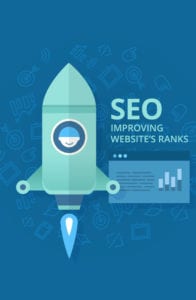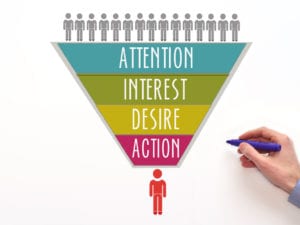5 Top Reasons to Invest in Content
If you want to drive conversions, you need to attract people to your website. If you’re going to entice visitors to your website, you need search engines to lead them there. What’s the best way for search engines to find you? By posting relevant, high-quality content. Relevant, high-quality content requires an investment of time and possibly money, but it’s well worth the cost.
Before I explain how and why content is essential for improved website performance, I want to address some scuttlebutt that’s come up recently. Apparently, some people are being told (I’m not sure who’s telling them this) that they should minimize their websites; even (gasp) consider only having a single landing page. Let’s nip that idea in the bud right now. Less is not more when it comes to website performance! Without content, your site will not drive traffic. It’s that simple. Enough said.
Top 5 Reasons to Invest in Content
Google likes content
Hands down, the number one reason to post high-quality content is to please the Google gods! Good content is 
Okay, content makes Google happy, but how about other search engines?
This study found that Google sends 10 times more traffic to the average website than Facebook and more than 10 times for any other search engine.
Content marketing drives more conversions
There’s evidence that content can help increase conversions.
- After reading recommendations on a blog, 61 percent of online consumers in the U.S. decided to take action.
- Inbound marketers can double the average site conversion rate (from 6 to 12 percent) due to their content marketing efforts.
To optimize your content for conversions, be sure to include a clear call-to-action (CTA). Your CTA tells the reader what they need to do next, guiding them to the next step in the conversion process. Whether converting means making a purchase, getting more information, or contacting your sales team, it’s essential to make it clear to the reader within the content what you want them to do next.
Most visitors won’t be ready to engage with your organization the first time that they hear about you or land on your website. People go through a process before committing to a cause or organization. The process is frequently referred to as the marketing funnel and content marketing plays a pivotal role in each phase.
- Top-of-Funnel: At the top of the funnel, your potential supporters are just starting to become aware of your organization. At this stage, content can help educate them and get them the information they need to decide if they want to engage with you.
- Middle-of-Funnel: In the middle of the funnel, prospects evaluate their options about which organizations to
support. Content during this stage of the process can educate them about what makes your organization unique so that they can start to narrow their choices and come closer to a final decision to get involved.
- Bottom-of-Funnel: Once they reach the bottom of the funnel, they are ready to convert. Content during this stage can give a final nudge of encouragement to empower them to make an informed decision.
Optimized content helps improve your SEO efforts
Content plays a vital role in helping your organization build and improve search engine optimization (SEO), 
While more pages do not necessarily result in higher traffic, it does allow your brand to rank for more keywords. For instance, creating blogs on different topics relevant to your target audience gives you more chances to rank for the keywords that these target users are searching for on the search engines.
Not to mention, the more content you have on your site, the more reasons you give visitors to stick around. Google sees time spent on site as one indicator that your website provides valuable content, and remember, Google is the number one reason content is important.
Content establishes your organization as an expert and builds trust

Content builds relationships with supporters
Just as content can attract new supporters, it can also encourage existing supporters to continue their alliance. I’m talking about donor retention. Acquiring new donors is expensive and challenging work. Having a plan to keep these new donors engaged and coming back after their first donation is tremendously important. Delivering content marketing that reinforces their decision to support your mission immediately following their first click on your “Donate” button is an opportunity for your organization to stay top-of-mind and encourage supporters to become powerful advocates for your organization.
So what are we talking about when we refer to content?
Here are some a few common types of result-driving content to consider:
- Blogs: Blogs are an excellent way to drive traffic to your website. It’s important to write and post blogs regularly so visitors get consistently fresh content.
- Videos: As platforms like YouTube continue to rise in popularity, videos continually grow as a popular way for businesses to market online.
- Ebooks: Ebooks provide your audience with everything they need to know about a topic. This provides in-depth content to allow you to cover all the bases of your topic to ensure your audience has a full understanding of the information. Many organizations create ebooks and offer them to clients in exchange for contact information.
- Infographics: Infographics are visual images that present data and information in an easily digestible format. It’s a great way to show statistics to help users better understand them.
- Landing pages: Landing pages give visitors a place to, well land, when they’re searching for something specific. That way, they don’t have to dig around your site to find what they want.
- Webinars: Webinars provide an excellent opportunity to share your knowledge and expertise with your audience. This content marketing strategy allows you to share information with your audience through live video.
- Online guides: Guides are in-depth pieces of content that allow you to give your audience a more detailed look into a subject. This format provides your audience with a go-to source for information on a topic and can be offered as downloadable content in exchange for information.
These are just a few of the many types of content you have at your disposal. For the best results, you should use various formats to keep your content fresh and exciting for your audience.
Of course, the Google Ad Grant is an excellent opportunity to direct more traffic to your website and increase conversions. Our expert, professional staff is available to answer any questions you have about the grant and how it can help you promote your nonprofit organization. Find out how we’ve helped more than 350 nonprofit organizations achieve their goals. We love to help organizations succeed!

 support. Content during this stage of the process can educate them about what makes your organization unique so that they can start to narrow their choices and come closer to a final decision to get involved.
support. Content during this stage of the process can educate them about what makes your organization unique so that they can start to narrow their choices and come closer to a final decision to get involved.



